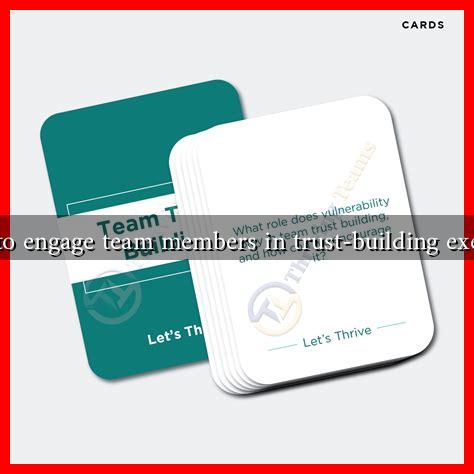-
Table of Contents
- How to Engage Team Members in Trust-Building Exercises
- The Importance of Trust in Teams
- Strategies for Engaging Team Members
- 1. Start with Icebreakers
- 2. Foster Open Communication
- 3. Engage in Team-Building Activities
- 4. Encourage Vulnerability
- Measuring the Impact of Trust-Building Exercises
- Conclusion
How to Engage Team Members in Trust-Building Exercises
Trust is the cornerstone of any successful team. When team members trust one another, collaboration flourishes, communication improves, and productivity soars. However, building trust is not an overnight process; it requires intentional effort and engagement. This article explores effective strategies for engaging team members in trust-building exercises, providing insights, examples, and actionable steps to foster a culture of trust within your organization.
The Importance of Trust in Teams
Before diving into trust-building exercises, it’s essential to understand why trust matters. According to a study by the Forbes Human Resources Council, organizations with high trust levels experience:
- Increased employee engagement
- Higher retention rates
- Improved collaboration and innovation
- Enhanced overall performance
These benefits highlight the necessity of fostering trust within teams, making it imperative for leaders to engage their members in trust-building exercises.
Strategies for Engaging Team Members
Engaging team members in trust-building exercises requires creativity and a genuine commitment to fostering relationships. Here are several strategies to consider:
1. Start with Icebreakers
Icebreakers are a great way to kick off trust-building activities. They help team members get to know each other in a relaxed environment. Examples include:
- Two Truths and a Lie: Each member shares two true statements and one false statement about themselves, and others guess which is the lie.
- Common Ground: Team members find three things they all have in common, fostering connection.
These activities can be particularly effective in remote settings, where team members may not have the opportunity for casual interactions.
2. Foster Open Communication
Creating an environment where team members feel safe to express their thoughts and feelings is crucial. Consider implementing:
- Regular check-ins: Schedule weekly or bi-weekly meetings where team members can share updates and concerns.
- Anonymity tools: Use platforms like Slido or Mentimeter to allow team members to voice their opinions anonymously.
Open communication builds trust by demonstrating that every voice matters.
3. Engage in Team-Building Activities
Team-building exercises can be both fun and effective in building trust. Here are some ideas:
- Escape Rooms: These require teamwork and problem-solving, encouraging collaboration under pressure.
- Volunteer Together: Participating in community service can strengthen bonds as team members work towards a common goal.
According to a study by the Team Bonding, 86% of employees believe that team-building activities improve workplace relationships.
4. Encourage Vulnerability
Vulnerability is a powerful tool in building trust. Encourage team members to share personal stories or challenges they’ve faced. This can be facilitated through:
- Storytelling sessions: Allocate time for team members to share experiences that shaped them.
- Feedback loops: Create a culture where constructive feedback is welcomed and appreciated.
When team members see each other’s vulnerabilities, it fosters empathy and understanding.
Measuring the Impact of Trust-Building Exercises
To ensure that your trust-building efforts are effective, it’s essential to measure their impact. Consider using:
- Surveys: Conduct pre- and post-exercise surveys to gauge changes in team dynamics.
- Performance metrics: Monitor productivity and collaboration levels before and after implementing trust-building exercises.
These metrics will help you assess the effectiveness of your initiatives and make necessary adjustments.
Conclusion
Engaging team members in trust-building exercises is a vital investment in the health and productivity of your organization. By implementing icebreakers, fostering open communication, organizing team-building activities, and encouraging vulnerability, you can create a culture of trust that enhances collaboration and performance. Remember, trust is not built overnight; it requires consistent effort and engagement. By measuring the impact of your initiatives, you can refine your approach and ensure that your team thrives in a trusting environment.

